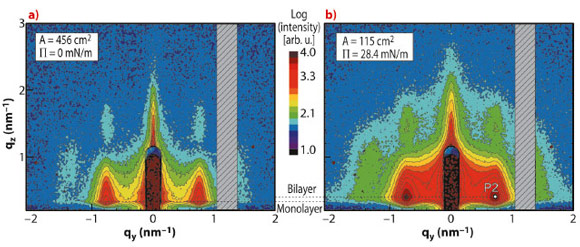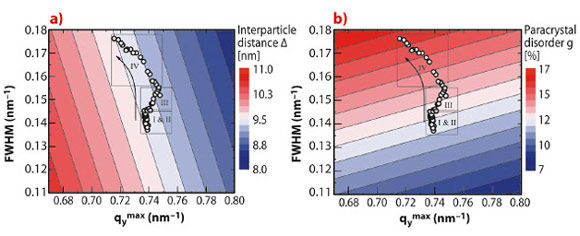- Home
- Users & Science
- Scientific Documentation
- ESRF Highlights
- ESRF Highlights 2012
- Soft condensed matter
- New non-equilibrium compression phase in a nanoparticle Langmuir film
New non-equilibrium compression phase in a nanoparticle Langmuir film
Large-area homogenous nanoparticle arrays are attractive for novel applications. They are fabricated by a transfer onto a substrate of self-assembled nanoparticle Langmuir films confined at the air/water interface that are formed by a controlled compression of the nanoparticles spread on the water subphase into close-packed self-assembled layers. We performed a fast-tracking in situ grazing-incidence small-angle X-ray scattering (GISAXS) study of the compression process and revealed a new non-equilibrium phase preceding the collapse of the nanoparticle monolayer.
The GISAXS measurements [1] of the silver nanoparticle Langmuir films during compression on the water subphase with a constant speed were performed at beamline ID10B. Figure 79a shows the GISAXS pattern of the nanoparticle submonolayer film at the surface pressure of 0 mN/m. The first Bragg rod corresponding to (10) diffraction is an evidence of lateral correlation between the nanoparticles organised into small self-assembled islands on the water surface. The GISAXS pattern of the collapsed nanoparticle monolayer at the surface pressure of 28.4 mN/m is shown in Figure 79b. The intensity modulation observed along the first Bragg rod indicates the nanoparticle bilayer formation while the peak marked as P2 suggests the vertical correlation in the nanoparticle bilayer. In order to track the temporal evolution of the nanoparticle monolayer during the continuous compression in real time, a series of fast recorded GISAXS patterns (“snapshots”) was taken and the first Bragg rod position and intensity distribution were analysed.
 |
|
Fig. 79: GISAXS pattern of the self-assembled nanoparticle (a) submonolayer and (b) collapsed monolayer. |
The analysis was based on the paracrystal model [2]. In particular, numerical simulations of the GISAXS patterns with systematic variation of the interparticle distance and paracrystal disorder based on the distorted wave Born approximation provided a paracrystal “landscape” in the reciprocal space (Figure 80) where the experimental points in terms of the first Bragg rod maximum position (qy) and width (FWHM) could be inserted (open circles). These points for various surface pressures during the film compression show a “pathway” characterising the Langmuir film behaviour within the paracrystal model. Four compression stages could be distinguished in the simultaneously measured surface pressure isotherms that are indicated along the “pathway”.
In stage I of the nanoparticle film compression, we do not observe any increase in the surface pressure. The isolated self-assembled nanoparticle islands coalesce into larger domains, forming a compact percolated network of nanoparticles. Stage II is accompanied by a steady increase of surface pressure. The mechanical stress induced at the boundaries of the coalesced nanoparticle islands leads to a re-ordering and densification of the percolated network and a slight increase in the paracrystal disorder while the interparticle distance remains constant. As a result, a homogenous self-assembled nanoparticle monolayer forms. A further increase in the surface pressure (stage III) results in the paracrystal disorder increasing by 1% and the mean interparticle distance decreasing by 0.2 nm. This effect can be attributed to a compression of the organic nanoparticle shell and formation of a previously unobserved transient phase far from equilibrium that could be observed solely due to our fast tracking GISAXS scheme. A further increase in the surface pressure (stage IV) leads to an irreversible 2-D to 3-D transition and the second layer formation that is accompanied by a relief of the stress accumulated in the first layer. Simultaneously, the voids and defects in the first layer are formed that results in a significant increase of the paracrystal disorder by 2% and relaxation of the interparticle distance back to the initial value.
The in situ observation of the non-equilibrium phases in the nanoparticle Langmuir film compression by conventional imaging and scanning probe techniques like SEM, TEM, STM or AFM is principally impossible. The newly-observed non-equilibrium compression phase documents unique potential of the synchrotron-based time-resolved X-ray scattering measurements in tracking fundamental properties of matter at the nanoscale.
Principal publication and authors
K. Vegso (a), P. Siffalovic (a), E. Majkova (a), M. Jergel (a), M. Benkovicova (a), T. Kocsis (a), M. Weis (a), P. Siffalovic (a), K. Nygård (b) and O. Konovalov (b), Langmuir 28, 10409 (2012).
(a) Institute of Physics, SAS, Bratislava (Slovakia)
(b) ESRF
References
[1] G. Renaud, R. Lazzari and F. Leroy, Surf. Sci. Rep. 64, 255 (2009).
[2] R. Hosemann and S.N. Bagchi, Direct analysis of diffraction by matter (North-Holland Publ. Comp., Amsterdam, 1962).




